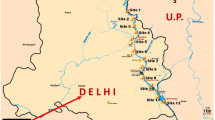Abstract
Concentration of heavy metals (Cd, Ni, Zn, Fe, Cu, Mn, Pb, Cr, Hg and As) in the waters of River Yamuna and in the soil of agricultural fields along its course in Delhi are reported from 13 sites, spread through the Delhi stretch of Yamuna, starting from the Wazirabad barrage till the Okhla barrage. Varying concentration of heavy metals was found. Peaks were observed in samples collected downstream of Wazirabad and Okhla barrage, indicating the anthropogenic nature of the contamination. The Wazirabad section of the river receives wastewater from Najafgarh and its supplementary drains, whereas the Shahdara drain releases its pollution load upstream of the Okhla barrage. Average heavy metal concentration at different locations in the river water varied in the order of Fe>Cr>Mn>Zn>Pb>Cu>Ni>Hg>As>Cd. The river basin soil shows higher level of contamination with lesser variation than the water samples among sampling locations, thereby suggesting deposition over long periods of time through the processes of adsorption and absorption. The average heavy metal concentration at different locations in soil varied in the order of Fe>Mn>Zn>Cr>Pb>Ni>Hg>Cu>As>Cd.
Similar content being viewed by others
References
Abbasi, S. A., Abbasi, N., & Soni, R. (1998). Heavy Metals in the Environment. New Delhi: Mittal Publications.
Clesceri, L. S., Greenberg, A. E., Trussell, R. R. et al. (1998). Methods for Examination of Water and Waste Water. Washington, DC: APHA, AWWA, WEF.
CPCB (Central Pollution Control Board) (2006). Water quality status of River Yamuna 1999–2005, Nov.
CPCB (Central Pollution Control Board) (2011). Control of Urban Pollution. http://www.cpcb.nic.in/oldwebsite/New%20Item/Maintinance-STPS/AK-Sinha-STP2.doc. Accessed 8 Feb 2011.
Elder, J. F. (1989). Metal biogeochemistry in surface-water systems—A review of principles and concepts. U S Geological Survey Circular 1013, 43.
ICRCL (Interdepartmental Committee for the Redevelopment of Contaminated Land) (1987). Guidance on the Assessment and Redevelopment of Contaminated Land. Paper 59/83 second edition. London: Department of the Environment.
Kaur, R. (2007). Regional resource characterization through remote sensing & GIS for effective decision making—A Case Study of NCR. [A note prepared for an Indo-US workshop on Innovative E-technologies for Distance Education, Extension/Outreach in Efficient Water Management, March 2007, ICRISAT, Patancheru, AP, India].
Lo, E. K., & Fung, Y. S. (1992). Heavy metal pollution profiles of dated sediments cores from Hebe Haven, HongKong. Water Research, 26(12), 1605–1619.
McKinney, J., & Rogers, R. (1992). Metal bioavailability. Environmental Science and Technology, 26, 1298–1299.
Ontario (1993). Guidelines for the protection and management of aquatic sediment quality in Ontario (p. 3), August 1993. ISBN 0-7729-9248-7, Queen’s printer for Ontario. Log 92-2309-067.
Rawat, M., Moturi, M. C. Z., & Subramanian, V. (2003). Inventory compilation and distribution of heavy metals in waste water from small-scale industrial areas of Delhi, India. Journal of Environmental Monitoring, 5(6), 906–912.
TERI (The Energy and Resources Institute) (2001). How Delhi makes the sprightly Yamuna a ‘dead river’. TERI report. http://www.unwac.org/research_articles.php. Accessed 15 January 2009.
USEPA (1985). Guidelines for deriving numerical national water quality criteria for the protection of aquatic organisms and their uses. PB85- 227049. In C. E. Stephan, D. I. Mount, D. J. Hansen, J. H. Gentile, G. A. Chapman, W. A. Brungs (Eds.), National Technical Information Service. Springfield, VA. Found at: epa.gov/waterscience/criteria/aqlife.html.
USEPA (1992). USEPA Office of Water, Fact Sheet: National Primary Drinking Water Standards, EPA 570/9-91-012FS (August 1991).
USEPA (US Environmental Protection Agency) (1995). Method 3050 B, Acid Digestion of Sediments, Sludges, and Soils. In Test Methods for Evaluating Solid Waste, Physical/Chemical Methods, 3050 B 1-3050B 12. Washington DC: US EPA. p.3500.
USEPA (2005). National Recommended Water Quality Criteria, United States Environment Protection Agency, Office of Water. http://www.epa.gov/ost/criteria/wqctable/.
Zhang, J., & Huang, W. W. (1993). Dissolved trace metals in the Huanghe: The most turbid large river in the world. Water Research, 27(1), 1–8.
Author information
Authors and Affiliations
Corresponding author
Rights and permissions
About this article
Cite this article
Sehgal, M., Garg, A., Suresh, R. et al. Heavy metal contamination in the Delhi segment of Yamuna basin. Environ Monit Assess 184, 1181–1196 (2012). https://doi.org/10.1007/s10661-011-2031-9
Received:
Accepted:
Published:
Issue Date:
DOI: https://doi.org/10.1007/s10661-011-2031-9




